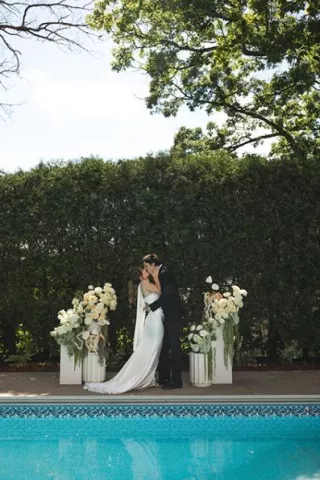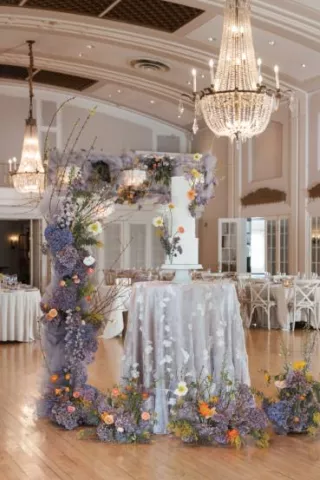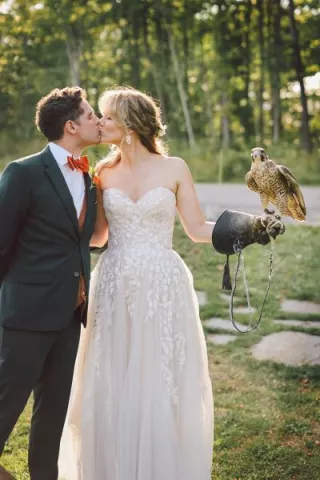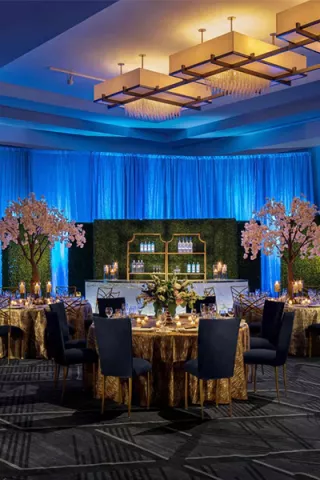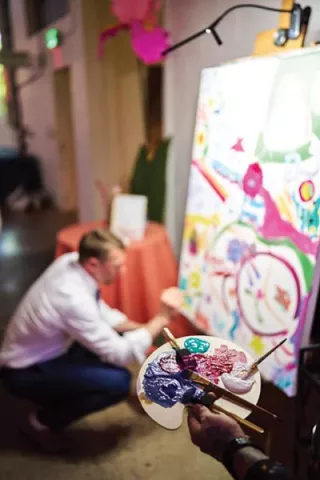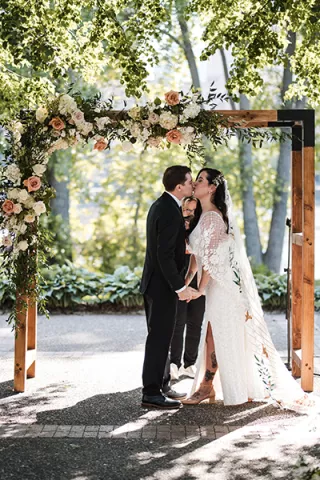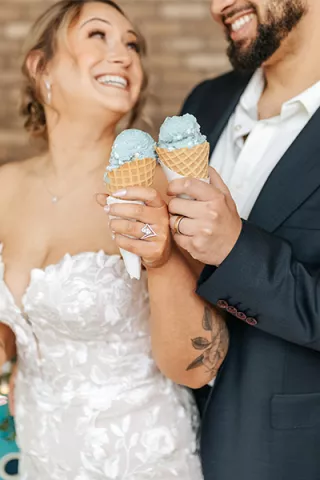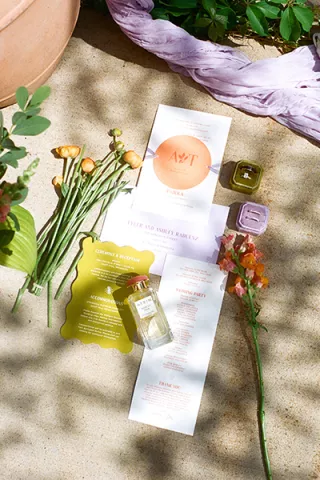A growing trend in weddings, slideshows—or photo montages—convey the history of a couple. Ranging from a simple progression of still images to a big video production, they can include everything from music and movie cutaways to digital special effects. Many begin with childhood shots of the bride and groom, then photos of the couple as their love blossoms. There’s no right or wrong way to make a slideshow—what’s right for your celebration is as personal as your relationship itself.
Consider Your Audience
Think through what you’ll put in your slideshow: Not only do you want the images to tell your story, you want it to be appropriate and relevant to your guests. Consider who’s attending and what they’d be interested in watching. Too many photos of friends out partying might prove tedious to a group of your parents’ colleagues, for example.
Elizabeth Pershing’s brother-in-law put together a photo montage for her wedding to groom Bryan. “He asked us to give him 50 or 60 pictures,” says Pershing, who displayed the montage during her reception at the Prom Center in Oakdale. “We knew which pictures were in it, so we felt comfortable. We totally trusted him to be tasteful.”
A long guest list may warrant a more general theme, while a detailed montage with narration might work better for intimate gatherings. “You don’t want to bore your guests,” says Kristi Bilger, videographer and owner of Personal Touch Media in Jordan. “It might not be boring to you, but when you have a couple of hundred people up there watching and it’s just a photo, they have no idea what’s going on.”
Bilger suggests montages start with pictures of the bride and groom as kids, then move chronologically through their lives to the engagement period, informing the audience by adding dates and/or captions. The couple’s favorite songs can be included to capture the spirit of their relationship. Since your montage is a reflection of who you are as a couple, silly or impromptu photos may be appropriate and add entertainment value.
Dustin Emmick of Lakeville surprised his bride, Nicole, with a montage he put together for their wedding. “You can throw in your embarrassing photos and have fun with it,” he explains. “It’s a way for people to reminisce, to get emotionally involved, and for people to laugh, too.”
Brevity is crucial. “Don’t go over nine minutes,” advises Brenda Rogers, catering director at Lafayette Club in Minnetonka Beach. “I think people really enjoy montages if they’re kept short. Any time you have over 300 people and you want to get to a great band and dance, you have to keep it short and keep the flow going.”
Dave Aug, videographer and co-owner of Aperture 24 in Minneapolis agrees. “You want to keep it to five to 10 minutes maximum,” he suggests, adding that each slide will be up for approximately five seconds, totaling 60 to 120 images.
Timing is Everything
Choosing the right moment to display the montage is almost as important as the right content. Couples can air their slideshows during the ceremony, receiving line or reception, depending on the logistics of your wedding.
Guests are sometimes distracted before dinner, milling around, chatting with one another and wondering when the food is going to arrive, which could take some of the focus off the show. “If I could do it again, I would probably do it while people were eating or right when we served the cake,” said Pershing, who played her wedding montage before guests ate dinner.
Sherri Cosentino, owner of Aalon Events, which plans 15 to 20 weddings annually, likes the idea of moving a looping montage display to the side or to a room that’s large enough to accommodate a flow of traffic, allowing guests to come and go as they please. She suggests airing the slideshow during cocktail hour when guests are mingling. “It can be awkward when there’s 200 people in a room and everyone’s forced to watch a video,” says Cosentino. “People feel like they can’t move, they’re cranking their heads around, they can’t go to the bathroom, they can’t get a drink. You just want your guests to enjoy it. I like the continuous, looping video. Sometimes it’s nice when people can watch it at their own leisure.”
Running the Show
You may be tempted to create your own slideshow, but before you start sorting through pictures, consider how much time it will take to collect, scan and organize all the images. Doing it yourself might save you money, but it could also sap the energy you need to plan the rest of your wedding.
“I had zero experience,” said Emmick. “I have a friend who works for Geek Squad [an electronics assistance team], and I asked him to research the different programs we could use. We tried a few demos. The most time-consuming part was scanning all the photos and then labeling them in the order I wanted.”
As Emmick discovered, making your own slideshow requires a computer, lots of digital memory and the right software. If you’re lucky enough to have a generous and technologically savvy relative or friend who’s willing to create the montage, offer to select the music and images ahead of time.
For a polished, professional-quality slideshow, consider hiring a videographer. Aug has incorporated voiceovers and home movie clips into his clients’ slideshows since he began producing them four years ago. He averages 10 to 20 montage productions annually. “I find the main theme after looking at all the pictures,” he explains. “It gives the overall production a much better quality.”
Personal Touch Media’s Bilger offers a range of special effects for her montage clients. “I can do 3-D, split-screen. It’s more of a production,” says Bilger. “I listen to the words of the music and time the display of the images so that it actually flows.” She recommends keeping close track of your photos to ensure they don’t get lost or damaged in the mail. “Hand-deliver them to the videographer, or scan images yourself and copy them to a CD,” she says.
Choose your videographer carefully: Ask to view samples and check his or her Web site, equipment capability and add-on expenses. If you’ve already hired a videographer to film your ceremony or reception, ask him or her if there’s a package deal that includes a slideshow.
Once you’ve got a CD of your slideshow in hand, make sure you have the proper viewing equipment at your ceremony or reception site. You’ll need a laptop or DVD player, large screen, projector, speakers or audio system (many reception sites have an audio system; if not, ask your band or DJ), and enough cable to connect the laptop or DVD player to the audio. Finally, give the equipment and slideshow at least one run-through on-site before the wedding day.
